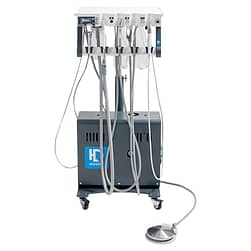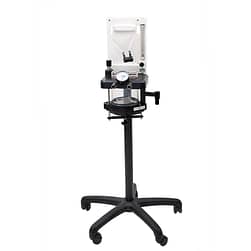
Table of Contents
Penrose drains have a variety of applications in veterinary practice. In most cases, they are used to evacuate fluids from subcutaneous tissues. Understanding the applications and limitations of Penrose drains is vital for any veterinary practitioner who treats wounds in clinical practice.
When are drains used?
In many situations, drains are placed prophylactically to prevent fluid accumulation. For example, if a bite wound creates a large amount of dead space or a mass removal results in the creation of dead space, a drain is often placed to prevent seroma formation.
Seromas can inhibit healing by placing additional pressure on the wound and providing a site for bacterial colonization, so drain placement is essential to the proper healing of some wounds.
If a patient has a wound with dead space that was not appropriately identified and addressed, a drain may be placed to treat an already-existing accumulation of fluid, such as serum, pus, or blood.
Drains may also be used to treat subcutaneous hematomas, such as aural hematomas, or to allow the drainage of pus from abscesses. Each of these is an appropriate indication for the use of a Penrose drain.
How are Penrose drains placed and maintained?
Before placing any type of drain, it is important to clip and scrub a wide area. This decreases the risk of bacterial contamination. Drains should be placed using sterile gloves and instruments – preferably on a veterinarian table or clean surface — in order to further decrease the risk of infection.
Penrose drains are passive drains, meaning that they should be always placed ventrally in a wound. These drains work via a combination of gravity, capillary action, and changing pressures related to the animal’s body movement. Placing the drain ventrally maximizes the likelihood that fluid will drain effectively.
If a drain is placed in association with a traumatic or surgical wound, it should exit through a newly-created incision. A drain should never be placed within an existing wound, because the inflammation associated with a drain can inhibit healing and lead to dehiscence of the entire wound.
If you are using a Penrose drain, it is important that the drain has only a single exit hole. The traditional technique, which leaves two free drain ends exiting the wound, has been associated with an increased risk of nosocomial infection. The drain must be anchored at the exit hole, using one or two sutures that pass through both the skin and the drain.
Differing views exist on whether the drain should also be anchored internally, with some veterinarians feeling that this helps secure the drain, and other veterinarians feeling that this approach increases the risk of drain fragments being left in the wound.
Penrose drains should be covered with a sterile dressing at all times in order to decrease the risk of ascending infection. Applying a thin layer of Vaseline around the drain hole can also help decrease bacterial incursion. When bandages are changed and drains or cleaned, sterile gloves should be used to decrease the risk of infection.
Pets with a drain should wear an e-collar at all times to keep them from removing their own drain.
When should Penrose drains be removed?
Drains are typically left in place until fluid production has significantly decreased.
In closed-suction drains, where fluid production can be measured, drains are typically removed when fluid production drops below 2 ml/kg per day.
Fluid production cannot be quantified when using a Penrose drain, but this guideline may still be helpful to approximate when fluid production has decreased enough for drain removal.
What are the pros and cons of Penrose drains?
Penrose drains are not the only drain available for wound care, but they are commonly used in many veterinary clinics. They have several key advantages over other types of drains, although they can have drawbacks as well.
Advantages of Penrose drains include:
- Penrose drains are inexpensive
Compared to some of the other drain options, which will be discussed below, Penrose drains are inexpensive for the veterinary practice and therefore inexpensive for the veterinary client.
- Penrose drains are soft and malleable
This makes them appropriate for a variety of applications. They can be used in many different types of wounds, and in many different locations on the body. This limits the need for a practice to stock a large variety of drains for wound care.
Disadvantages of Penrose drains include:
- Risk of ascending infection
The end of a Penrose drain is open to the environment. This allows bacteria to travel up the drain and into the wound, which increases the risk of ascending infection. Nosocomial infections present a particular risk in Penrose drain. These infections may be antibiotic-resistant in some cases.
- Inability to quantify the amount of wound discharge
When monitoring wound healing, it may be beneficial to quantify wound drainage. With a Penrose drain, this is not possible.
- Require gravity assistance for drainage
In order for a Penrose drain to drain a wound effectively, gravity must help pull the fluid down the length of the drain. This may not be possible for all wounds. For example, a wound on the dorsum may not be amenable to the use of a Penrose drain.
- Risk of pneumothorax
A Penrose drain does not limit the movement of air up the drain. If a wound communicates with the thorax, the use of a Penrose drain could lead to the presence of a pneumothorax.
What are the alternatives to Penrose drains?
In some applications, you may want to consider the use of a closed-suction drain instead of a Penrose drain. These drains consist of a fenestrated tube that is placed in the wound and attached to an external suction device.
An improvised closed-suction drain can be made with materials that are available in most veterinary practices:
Cut the syringe-adapter end from a butterfly catheter and use a needle to create multiple fenestrations in the length of the catheter tubing. This tube is then placed within the wound and secured to the skin with a Chinese finger-trap suture. The needle end of the butterfly catheter can then be inserted into a blood collection tube (vacutainer) to apply a small degree of consistent suction. This will only work with very liquid fluids (such as serum), but can be beneficial if a true closed-suction drain is not available.
If you are in a practice that places drains frequently, you may want to consider keeping a supply of true closed-suction drains available.
Types of closed-suction drains that may be used include:
- Redon drain
These drains are often used when managing wounds that are expected to generate a large amount of fluid, such as a severe bite wound or a large surgical wound. A Redon drain consists of a fenestrated tubing, attached to a grenade-style manual compression chamber. Once compressed, this chamber will have a tendency to re-inflate, placing a gentle vacuum on the wound.
- Jackson-Pratt drain
This drain is often used when draining the abdomen. Jackson-Pratt drains are specifically designed to limit obstruction by the abdominal structures and organs.
- Thoracostomy tubes
These drains are specifically designed to drain fluid or air from the thorax. They are flexible, resist collapse, and are available in a variety of tube diameters (to accommodate a variety of patient sizes and applications).
What are the benefits of using closed-suction drains?
Closed-suction drains offer a number of advantages over Penrose drains, depending on the specific application. These advantages include:
- Decreased risk of nosocomial infection
In a closed-suction drain, the end of the drain is closed. This prevents bacteria from entering the drain and creating an ascending infection.
- More effective fluid removal
The suction produced in a closed-suction drain can be more effective at removing all fluid from a wound.
- Decreased risk of occlusion
The presence of constant suction on the drain decreases the risk of occlusion with clots, fibrin, and other materials that can lead to the obstruction of Penrose drains.
- Drainage can be quantified
Closed-suction drains collect fluid in a vessel, allowing it to be quantified.
- No large dressings needed
As discussed previously, Penrose drains should be covered with a sterile dressing at all times. This is not necessary with a closed-suction drain, because the drain is less susceptible to bacterial contamination.
The bottom line
While Penrose drains have significant advantages in affordability and flexible application, it is important that they be used correctly in order to maximize the likelihood of a positive outcome.
There may be cases where a Penrose drain is not appropriate; in these situations, consider the use of a closed-suction drain.
Sources and further reading
- Ladlaw, Jane. 2010. “The Use and Abuse of Surgical Drains.” Presented at British Small Animal Veterinary Conference.
- Fox, Steven. 1988. The best methods of wound drainage in pets. Vet Med. May 1988; 83(5): 462-472.
- Saile, Katrin. 2015. “Drains: Proper Use and Management.” Presented at Central Veterinary Conference. Accessed at: http://veterinarycalendar.dvm360.com/drains-proper-use-and-management-proceedings







